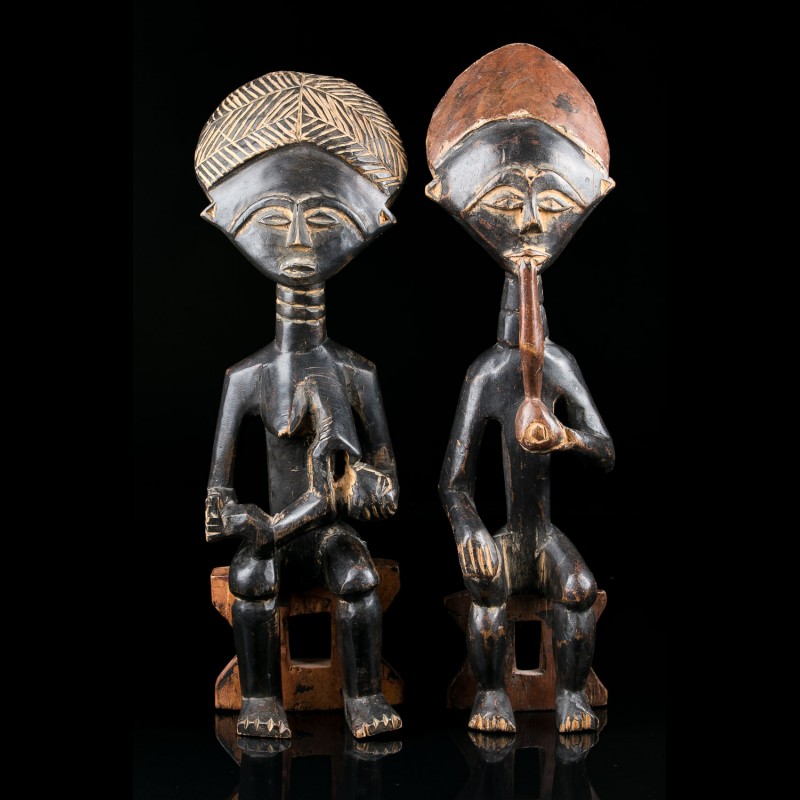








Akua’ba (pl. akua’ma; meaning ‘Akua’s children’) are small fertility figures found in shrines across Akanland. The Akan believe that, "the name akua’ba comes from the legend of a woman named Akua who was barren, but like all Akan women, she desired most of all to bear children. She consulted a priest who instructed her to commission the carving of a small wooden child and to carry the surrogate child on her back as if it were real. Akua cared for the figure as she would a living baby, even giving it gifts of beads and other trinkets. She was laughed at and teased by fellow villagers, who began to call the wooden figure akua’ba, or “Akua’s child.” Eventually though, Akua conceived a child and gave birth to a beautiful baby girl. Soon thereafter, even her detractors began adopting the same practice to overcome barrenness."Following the example set by Akua, barren Akan women, or those newly married and hoping for children, have a personalised akua’ba figure created to reverse the curse of infertility. These figures are blessed and consecrated by Akan priests in atano shrines; the priest prays to the spirits to deliver a living child to his client. Once consecrated, the owners of the figure must care for it like it is indeed a living child, the figure must be caressed, carried, protected and fed, some are even given jewellery in the form of glass beads and clothing to enhance their beauty.Once the owner becomes a mother through birth, the akua’ba is returned to the priest and added to the spirit’s shrine as a thanks offering for the real child delivered. Atanoshrines can feature up to 10 akua’ma figures; the large number of figures is a sign of the spirits power and ability to help Akan women conceive. In some cases, the akua’ba figure is kept by the family as an heirloom or giving to the child as a toy.The art of Ashanti can be classified into two main groups: metalwork (casts of brass or gold using a lost-wax method and objects made of hammered metal sheets) and woodcarvings. Fertility and children are the most frequent themes in the wooden sculptures of the Asante. Thus the most numerous works are akua’ba fertility figures and mother-and-child figures called Esi Mansa. The acua’ba are dolls with disk-shaped heads embodying their concept of beauty and carried by women who want to become pregnant and to deliver a beautiful child. The fame of these objects derives from a legend asserting that a woman who has worn one will give birth to a particularly beautiful daughter. A Ghanaian source indicates another use: when a child disappeared, the acua’ba statue was placed with food and silver coins at the edge of the forest to attract the malevolent spirit responsible: the spirit would then exchange the child for the statue. Sculptured mother-and-child figures show the mother nursing or holding her breast. Such gestures express Asante ideas about nurturing, the family, and the continuity of a matrilineage through a daughter or of a state through a son. The mother-and-child figures are kept in royal and commoner shrines where they emphasize the importance of the family and lineage. The Asante are famous for their ceremonial stools carved with an arched sit set over a foot, referring to a proverb or a symbol of wisdom. They are usually made for a chief when he takes office and are adorned with beads or copper nails and sheets. In rare cases, when the chief is sufficiently important, the stool is placed in a special room following his death to commemorate his memory. Asante chairs are based on 17th-century European models and, unlike stools, do not have any spiritual function. They are used as prestige objects by important chiefs during festivities or significant gatherings.SpecsOriginEx private collection FrenchSize38 x 11 cmDatingCirca 1960Material(s)Wood
Data sheet
You might also like